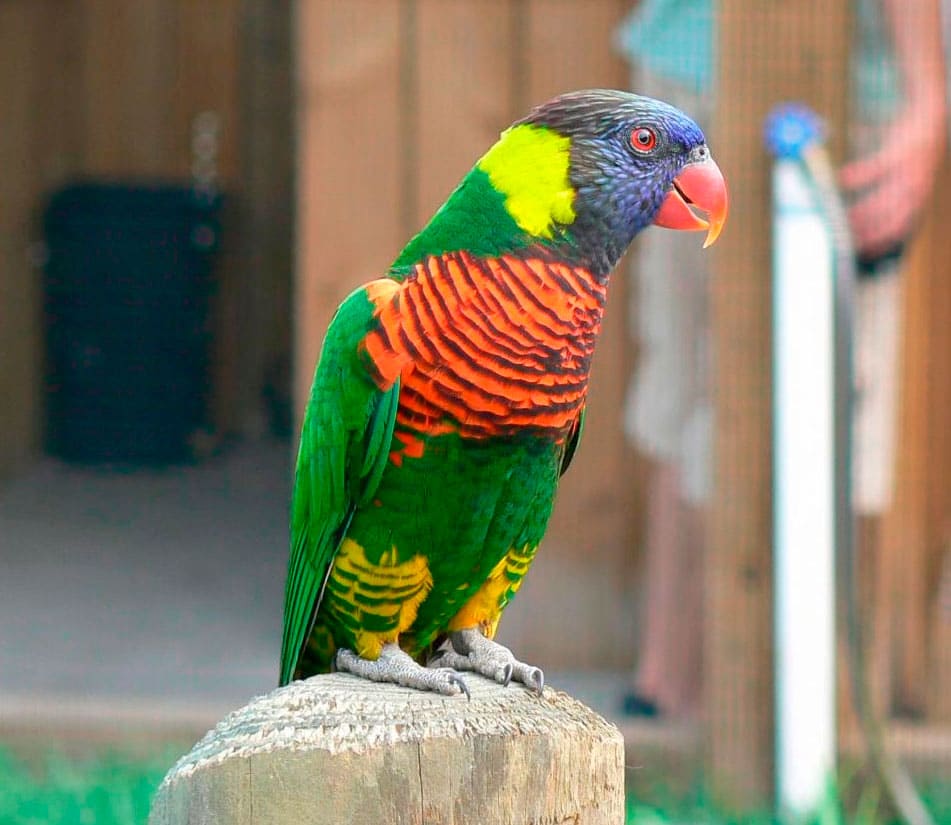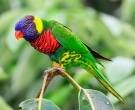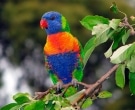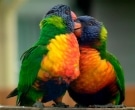Content |
|---|
Description:
26 cm.. of length and weight 100-157 g.
The Coconut Lorikeet (Trichoglossus haematodus) are colourful birds that find us almost all the colours of the Rainbow in their plumage.
Have the front of the crown, face and throat Dark bluish mauve, with violet stripes on the front of the crown, ear-coverts and part low of them cheeks; the rest of the head is dark blue with the bases of feathers brown-black color, especially around the rear of the crown and throat, and with greenish stripes at the rear of the crown.
The upperparts are of color green brilliant with specks of color reddish in the center of the the mantle (bases of feathers), and collar back brighter yellowish green.
The primaries with the tips blackish; a patch bright yellow in the innerwebs of the flight feather, that tends to orange in the secondaries; outerweb of the primaries and under wing-coverts, green. Underwing-coverts orange-red; the flight feather dark gray in tips.
The Breast , the upper part of the abdomen and flanks bright reddish orange top, barred dark blue, tending to green at the bottom of the chest; abdomen with brands of color green in the Center, sometimes forming a discrete patch or interspersed with reddish orange; abdomen and the thighs with a beaming green and yellow with bases of color yellow; undertail-coverts of color yellow with tips of color green glossy. Upper, the tail of color green with them innerwebs of the lateral feathers yellowish: undertail, the tail greyish green in the outerweb, yellow in the innerwebs.
The bill orange red: the irises orange-red; legs gray or greenish gray.
Both sexes are very similar.
The immature they are more muted than adults, with the bill and the irises dark brown and tail more pointed.
- Sound of the Coconut Lorikeet.
Habitat:
The Coconut Lorikeet they are parrots of the Plains and Highlands. They are distributed by a wide variety of habitats such as mangrove forests, Moors and heathland near the coast, wooded meadows, tree galleries, reforestation during regeneration and rainforests.
In all cases, they need places with abundant flowers.
The Coconut Lorikeet they have also colonized habitats formed by man: coconut plantations, orchards and gardens on the outskirts of cities. They mark a greater preference for edges and clearings inside the dense jungles. Gladly tolerate the areas with degraded vegetation and plantations of small size in the small atolls.
They are birds sedentary, that does not prevent to do short trips looking for trees in flower. Because of these movements, populations appear to vary locally. Very gregarious, they live in pairs or in bands that can vary from a few birds to several hundred, Depending on the availability of food resources.
These birds are very active and noisy, flying a bit randomly above the tops of the trees or climbing up the branches in search of flowers or fruits.
during their search for food, the Coconut Lorikeet they usually share the space with other species of frugivores.
When they are hidden among the leaves, their cries of call reveal their presence.
They adopt a flight very quick and direct.
Son monogamous. During courtship, the couple is side-by-side, swaying, the neck forward and the pupil dilated. They wave irregularly wings to reveal the clear band that crosses its sub-wing.
Reproduction:
The breeding season performed at different times depending on the distribution area.
The species nominal eat your laying between September and December. Both members of the couple set up their nests in a tree cavity, usually a eucalyptus. Several nests, two or three may be in the same tree, but the entrance of the nest will fiercely defend against any intrusion.
In the the Admiralty Islands, the Coconut Lorikeet Sometimes they nest in the ground. The female normally lays 2 eggs on a bed of wood rotting chips. She incubated alone for a few 25 days.
The young chicks are altricial and need to 8 weeks to fend for if same. As soon as they are autonomous, they bind to the bedrooms and common bands.
Food:
The Coconut Lorikeet they have a bill acute equipped with a language composed of some structures similar to hairs tiny called papilla it help excavate the pollen and the nectar from the flowers.
Also eat fruits, berries, seeds, outbreaks and insect larvae.
In Australia, they forage primarily in eucalyptus trees and trees of the genus Banksia, in particular, coastal Banksia (Banksia integrifolia) and river banksia (seminuda), trees that often exceed the 15 metres in height.
They are also found in farmland, since they are particularly cultivated fruits and seeds Milky enthusiasts.
Easily entering gardens to steal fruit and not disdain approaching feeders
Distribution:
Size of its range (breeding/resident ): 5,310,000km 2
Endemics Oceania, at the edge of the Asian continent.
Can be found in Australia, in the East of Indonesian, Papua New Guinea, New Caledonia, the Solomon Islands and Vanuatu.
In Australia, mostly found on the coast, to the North of Queensland in the South of Australia and Tasmania.
Conservation:
• Red List category of the UICN current: Least concern
• Population trend: Decreasing
The species has undergone intense trade: from 1981 When it began trading in CITES Appendix II and through the year 2005, 100.388 individuals were captured in the wild and reported in the international trade.
In some places of Australia, It is hunted for food and feathers are later used in ritual ceremonies
"Coconut Lorikeet" in captivity:
I recommend to read first hand information:
Alternative names:
– Coconut Lorikeet, Rainbow Lorikeet (Coconut) (English).
– Loriquet à tête bleue (French).
– Allfarblori (German).
– Lóris-arco-íris (Portuguese).
– Lori Arcoiris, Lori de cocotero, Tricogloso de Pecho Rojo (español).

scientific classification:
– Order: Psittaciformes
– Family: Psittaculidae
– Scientific name: Trichoglossus haematodus
– Citation: (Linnaeus, 1771)
– Protonimo: Psittacus haematod . [sic]
Images “Coconut Lorikeet”:
Videos "Coconut Lorikeet"
“Coconut Lorikeet” (Trichoglossus haematodus)
-
Sources:
– Avibase
– Parrots of the World – Forshaw Joseph M
– Parrots A Guide to the Parrots of the World – Tony Juniper & Mike Parr
– Birdlife
– Oiseaux.NET
– Photos:
(1) – Rainbow Lorikeet perching on a wooden post at Tanganyika Wildlife Park, Kansas, USA. by Snowmanradio – Wikipedia
(2) – A Green-naped Lorikeet, T. h. haematodus, a sub-species of Rainbow Lorikeet, Trichoglossus haematodus at Jurong Bird Park, Singapore. by Benjamint444 – Wikipedia
(3) – A Rainbow Lorikeet (Trichoglossus haematodus moluccanus) in Melbourne, Australia. by Alfred Sin – Wikimedia
(4) – Lorikeets feeding on the flowering tree, Corymbia ‘Summer Beauty’ (cultivar). Photographed in suburban Brisbane, Australia. by Tatiana Gerus – Wikimedia
(5) – Two birds preening each other. Jervis Bay, New South Wales, Australia by Arnie Hollyman – ibc.lynxeds.com
– Sounds: Patrik Åberg, XC215305. accessible www.xeno-canto.org/215305







How many a year is born? And and how many months of gestation